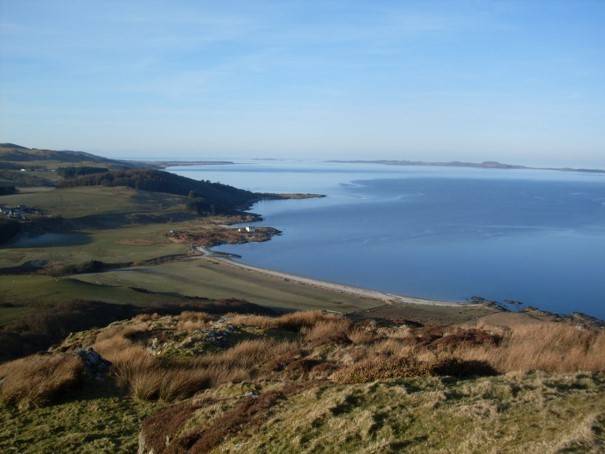Dun Skeig Fort
John MacLaren Wyllie
Dun Skeig Fort
"Anyone who has lived or visited Clachan area of Kintyre will soon become aware of the massive single hill of Dun Skeig that stands proud above Clachan beach at the entrance to West Loch Tarbert. This prominent landmark is visible to all who pass under it in the Ferry as the ship ploughs its way to or from the Islands of Islay and Jura. It is always a welcome sight to fisherman with their heavy catch on their way up the loch and to sailors seeking sheltering from the stormy seas of the Atlantic.
"The remains of what appears to be defensive works are obvious on the summit. The hill rises some 469.5 feet on the shore-side where sheer cliffs of the Dun stand guard at the loch entrance. Various estimates are given as to when the site was first inhabited, but most probably by the late Iron Age to early Bronze Age. Evidence suggests some form of dwellings. There are remains of a large outer defence wall with two inner circular areas within it on top of the hill. But even earlier human activity has been found among the boulders at the foot of the cliff face and I have seen ‘Cup and Ring’ marks near the top. One of the inner circles has strong signs of ‘vitrification’ a term given to ancient building structures that has been subjected to intense heat and partly melted. This of course could have been a method of re-enforcing the fort, but there is also a suggest that maybe a wood structure once covered the inner circles and one was either set on fire by accident or deliberately under violent attack. In more recent time it may also have been used as a look-out post to prevent attack to the mainland from the seaward side by the likes of the Vikings or other invaders Because of its close proximity to Loup house it might also have been a vantage point to watch skirmishes that look place on the braes above Loup at the time of rebellious periods in 1647, during General Leslie’s march down Kintyre.
"Fortunately the landscape is much more peaceful today being mainly given over to sheep and some cattle, with much wild live to see on the slopes and a magnificent view for those willing to make the steep climb to the top. My interest in the area springs from the many walks in the surroundings. One of the best routes includes a round trip from the village up the old main road and branching off onto the old track over the foot hills beside Dun Skeig. On the way you pass some standing stones that are called ‘Moon Stones’ by locals and get a grand view up the loch. Walking down the other side you come to the pier at Portachaillan where once you could get a rowing boat ferry to Kiberry. If you continue walking round the foot of the hill, further on, the track bents round high walls of cliff, and reaches the sandy beach beside the dark heights of Dun Skeig. Here Clachan Burn finally opens out to the sea. By following the burn’s winding route up stream, it is possible to return back to the village.
I have often seen deer on the hill, high up near the top and hare running wild among bracken and heather patches or boxing in March. There are also buzzards to be spotted at this height along with the occasional raven. Further down by the beach there are many sea birds and seals to spot, but bird like curlews are not so common now. I also remember seeing more sand martins nesting in the banks of the burn. On the plant side the area is good for Bog Cotton and Bog Myrtle and indeed many herbal plants and low growing bushes flower profusely here during the summer.
"The greatest reward however is climbing this very high hill to sit among the ancient stone work. From here I can watch the ferry steam up the loch or turn my gaze to look towards Gigha and distant Islay and the Pap’s of Jura, or look in the other direction at the tops of the high mountains of Arran on the far side of Kintyre."
As told by by John MacLaren Wyllie
More information on visiting the area can be found here.
